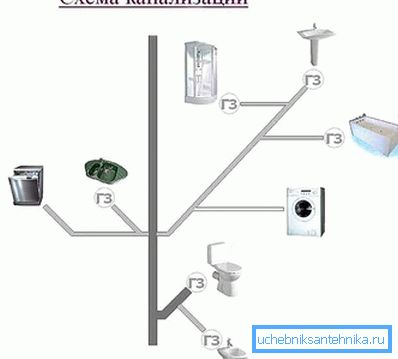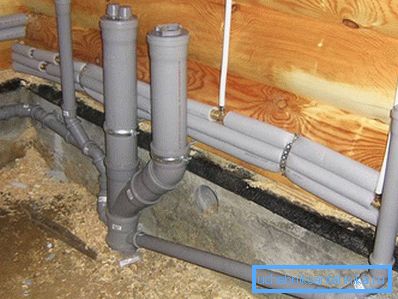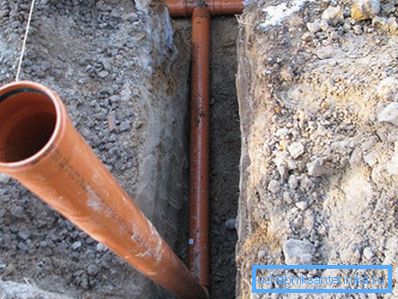Installation of the sewer system itself
The sewage system performs one of the important functions in the comfort of a residential building. No one accustomed to the conveniences a person can do without this sanitary structure. Therefore, the construction of your home, the construction of the sewer system is of paramount importance. The sewage system consists of an internal pipeline, an external pipeline and a sump.
Starting the construction of the system, it is necessary to take into account in which house you will perform all the work. This may be a house already built, or being under construction. After all, its functionality depends on the correct installation of the pipeline.
Special features

Laying of sewer pipes should be planned from the beginning of the construction of the house in order to properly withstand all slopes. And to carry out the installation in the already finished building, you will have to dig a large trench under the foundation. This will be required in order to lay all the pipes on the sand pillow.
Many fix sewer pipes under the floor with special fasteners. Such installation in the future may cause an emergency. The floor is in constant motion, although you do not notice it. It is affected by the weight of room furniture, the movement of people around the room, etc. And imagine the weight of the water in the pipes when you drain it into the sewer. Due to the effect of all these factors, a pipe suspended under the floor may crack or leave the joint. Then all the impurities will go under your foundation. In addition to the unpleasant smell in the house, it can sow the foundation. And this will entail the deformation of the walls.
Internal assembly

Plastic pipes of gray color O 50 and 110 mm are used for internal installation of the sewage system.
- First of all, make a diagram of your sewage system and mark up the wall where the pipe will pass.
- Buy all the necessary parts for installation and prepare the tool. In the wall and in the ceiling where the pipe will pass, punch holes through the perforator.
- Installation begins at the lowest point, that is, from the foundation of the house. Dig a trench under the floor from the foundation to the place where the pipe emerges from under the floor. Since the pipe must be laid on the street below the level of soil freezing, then under the floor you will need to dig the same depth for a smooth exit of the pipe from under the foundation.
- On the street, at the exit of the pipe from the foundation of the house, dig a pit. Using a punch, punch a hole in the foundation and insert a metal sleeve of a larger diameter than the sewer pipe. The sleeve will protect the plastic pipe from external pressure on it.
- Put sand on the bottom of the dug trench and level it. Now you can start laying the pipe from the exit from the foundation to exit from under the floor. To do this, you take the pipe O 110 mm, and connect it with sockets, which are located on the edge of each pipe. For better bonding, lubricate the O-ring with silicone.
- Place the connected pipes on the prepared sand cushion at an angle. The inclination angle for a pipe O 110 mm is 2 cm for each running meter, and for a pipe O 50 mm - 3 cm.
- In the place of the pipe outlet from under the floor, you begin to install a common sewer riser. It is also made of 110 mm pipe. Installation of the riser start by attaching to it a pipe that comes out from under the floor. Finish on the top point where the last sanitary fixture will be installed. If the construction involves a foot stand, then bring the pipe through the ceiling of the house to the street. Put the fungus on top of the pipe.
- As each pipe is connected, do not forget to put tees to connect plumbing fixtures. Attach each pipe with hose clamps to the wall.
- After installing the riser, connect to its tees all the sewer hoses that will pass through your house. They are made of plastic pipe O 50 mm. Connect the toilet directly to the riser through a 110 mm O pipe using a special corrugation.
- After installing the entire system, connect all plumbing fixtures to the hoses of your sewer.
On this internal installation is completed. Under the floor, bury the trench after laying the outer system and testing it. Although, to whom it is convenient. You can experience the internal system immediately. Drain some water from the top. Only without an outdoor system, it will run into the pit you dug under the foundation. Check all connections. If there is no leak anywhere, you can bury the pipe under the floor. And now proceed to the installation of the outdoor system.
Outdoor installation

It is worth starting with a sump. It is from it begins laying pipes. The pit must be positioned so that the outgoing pipes from the house have fewer turns during their laying. The best option if the pipe will be straight. Cesspools there are many species. Familiarize yourself with the different options, examine their device, and select the appropriate option.
- So, you have built a cesspool, and now you start digging a trench from it to the foundation of the house. The trench is digging to a depth below the level of soil freezing.
- The bottom of the trench is well leveled and poured sand pillow with a thickness of about 10 cm.
- Take the sewer pipe for external installation. They are distinguished by their orange color. Connect them and start laying from the sump to the house. Pipes are laid on a sand cushion with a slope of 2 cm by 1 m of pipe.
- If it turns out that you can't do without a turn, then put a tee on this place with a window for revision. Next, install a manhole at this location. Also, such wells are placed on every 10 meters of the track, if it is very long.
- Pave the entire pipe, connect it to the exit of the house. And now you can experience the entire system of your sewer. Drain a small amount of water in the house and check all connections.
- After a successful test, the sewer network, if it lies above the soil freezing layer, is insulated with a special insulation. They are on sale now a wide variety.
- And the last stage: fill the top of the pipe with sand or soft soil, and then with the rest of the earth.